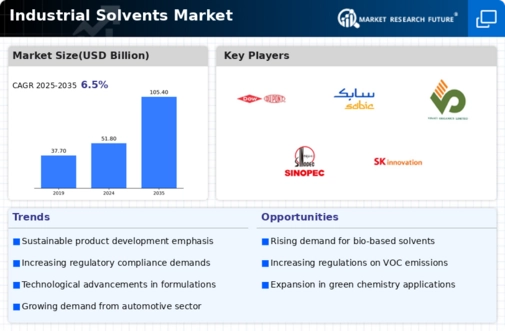Market Share
Industrial Solvents Market Share Analysis
Market share positioning strategies play a crucial role in the competitive landscape of the Industrial Solvents Market. Companies within this sector employ various tactics to capture and maintain their market share amidst fierce competition. One prevalent strategy is differentiation, where companies focus on unique characteristics of their solvents to stand out. This could involve offering solvents with specialized formulations tailored to specific industrial applications, such as pharmaceuticals, paints, or electronics manufacturing. By catering to niche markets or providing innovative solutions, companies can carve out their own segment of the market and reduce direct competition.
They have increased their use in the pharmaceutical industry since these goods are formulated to have certain features that allow them to dissolve in a variety of medicinal medications, driving product demand.
Another effective approach is cost leadership, which entails offering industrial solvents at lower prices compared to competitors. This strategy requires efficient production processes, economies of scale, and effective cost management. Companies may leverage bulk purchasing, streamlined manufacturing techniques, or strategic partnerships to lower production costs and pass on the savings to customers. By positioning themselves as the most cost-effective option in the market, companies can attract price-sensitive customers and gain market share even in saturated markets.
Furthermore, market segmentation is a fundamental aspect of market share positioning in the Industrial Solvents Market. By dividing the market into distinct segments based on factors such as industry verticals, geographic regions, or customer needs, companies can tailor their marketing efforts and product offerings more effectively. For example, a company may focus on serving the automotive industry by developing solvents specifically formulated for automotive coatings or cleaning applications. By understanding the unique requirements of each segment, companies can position themselves as the preferred choice within their target markets and capture a larger share of the overall market.
In addition to segmentation, effective branding and marketing are essential for establishing a strong market position. Companies invest in building brand recognition and loyalty through targeted advertising campaigns, product promotions, and industry partnerships. By communicating the value proposition of their solvents and creating a positive brand image, companies can influence customer perceptions and preferences, ultimately driving market share growth. Consistent branding across all channels helps reinforce the company's positioning and differentiate it from competitors in the minds of customers.
Moreover, strategic alliances and partnerships can also play a significant role in market share positioning within the Industrial Solvents Market. Collaborating with distributors, suppliers, or research institutions allows companies to expand their reach, access new markets, and leverage complementary capabilities. For example, a solvent manufacturer may partner with a logistics company to improve distribution efficiency or collaborate with a research institution to develop innovative solvent formulations. By pooling resources and expertise, companies can strengthen their competitive position and gain a larger share of the market.
Furthermore, continuous innovation is key to maintaining a competitive edge and sustaining market share growth in the Industrial Solvents Market. Companies invest in research and development to improve existing products, develop new formulations, or explore alternative raw materials. Innovation allows companies to address evolving customer needs, comply with regulatory requirements, and stay ahead of competitors. By regularly introducing new and improved solvents to the market, companies can attract customers seeking cutting-edge solutions and maintain their market share leadership.








Leave a Comment